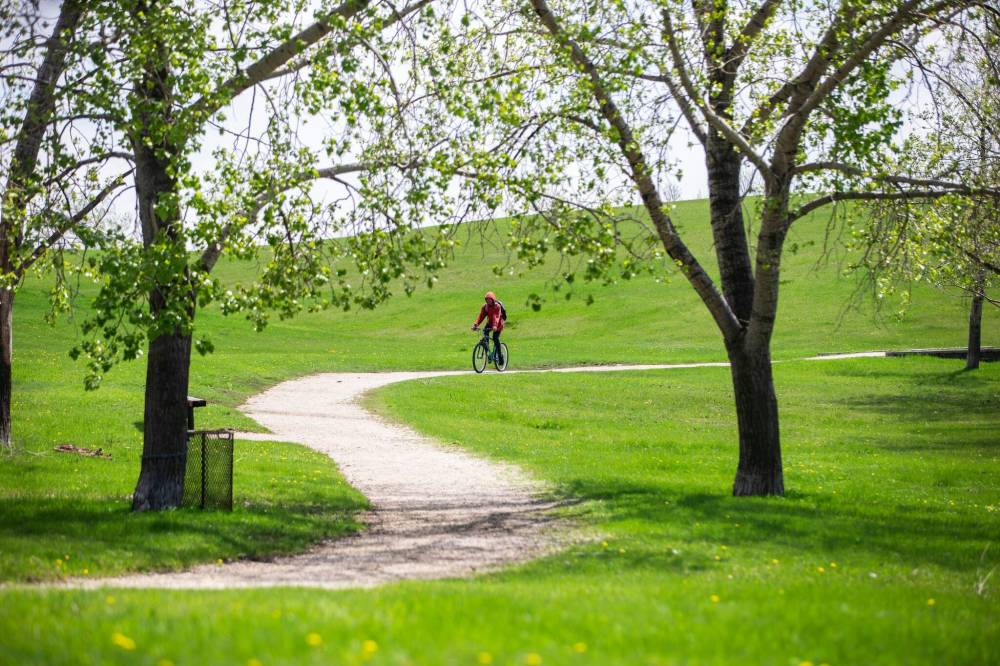The city is reimagining how Winnipeggers will move in the next 26 years and has set a goal for people to walk, cycle, take transit or rideshare for half of their trips by 2050.
Details of the ambitious target were shared in a new transportation master plan released Monday.
The city expects Winnipeg’s population to increase by 200,000 residents, to about one million, as of 2050 and says transportation priorities need to shift in response.

MIKAELA MACKENZIE / FREE PRESS FILES
New sidewalks, a bike network, road and bridge improvements, expanded road capacity, multimodal corridor improvements, and changing how and where trucks move throughout the city are proposed in the city’s 2050 transportation plan.
New sidewalks, a bike network, road and bridge improvements, expanded road capacity, multimodal corridor improvements, and changing how and where trucks move throughout the city are proposed in the plan.
Though walking, cycling and transit are more sustainable options for getting around, the plan acknowledges daily trips will continue to be made via personal vehicles.
As per the city’s recent pedestrian and cycling strategy, most trips in Winnipeg in 2021 (83 per cent) were made via a personal vehicle, with less than 10 per cent made by transit, and cycling or walking accounted for under seven per cent.
By 2050, the city wants to see the share of all trips in personal vehicles reduced to 50 per cent, with the remaining half split between ridesharing (21 per cent), transit (15 per cent) and walking/cycling (14 per cent).
“That’s a big bite. The only way we’re going to do that is (by) making it desirable. It’s not forcing people, it’s making it more desirable to take the bus, to walk, to bike and to do ridesharing,” public works committee chair Janice Lukes said.
Environmental concern is partly responsible for the shift in priorities since the 2011 master plan, but Lukes said money is the main motivator.
“It’s very expensive to design a city and operate a city all around personal vehicles,” she said, adding tax dollars from senior governments will be needed to realize the new plan, especially when it comes to transit.
The city is also updating truck routes and aims to reduce by 20 per cent the number of fatal or serious injury collisions come 2026.
It also seeks to provide accessible and affordable transportation options for all.
“Many streets and intersections are at capacity today,” the plan’s overview states.
The infrastructure can’t support movement or serve modes of transit and active transportation unless it receives “major investments,” the overview says.
Meanwhile, the city is contending with a “lean financial position” and would opt to maintain current infrastructure rather than building new, the overview states.
Everything in the plan is guided by priorities surrounding land use, moving people and goods, and emergency service access.
What could all this look like practically?
Housing along transit routes, more roads shared by vehicles and cyclists, truck-only lanes, better winter sidewalk maintenance, transit service to city outskirts, maximized road capacity, and bridge repairs were just some of the suggestions in the plan.
“It is a visionary plan, but it is a guiding document for making a lot of decisions,” Lukes said.
Feeding into the plan are a goods movement study, a road safety action plan – both presented in 2022 – and a 2024 pedestrian/cycling strategy.
Success, according to the plan overview, would mean solving “Winnipeg’s biggest transportation problems” and making “transportation safe and efficient for all.”
The city wants to get the word out about the proposed plan before a final version and a report go to council in the fall.
Six info sessions are scheduled between July 17 to 25 for residents. A telephone town hall, requiring registration in advance, is also planned for July 24.
jordan.snobelen@freepress.mb.ca